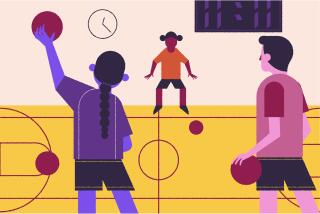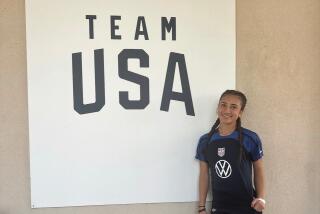Wave OF CONTROVERSY
Debate is stirring on cul-de-sacs, at the beach and at horse shows.
In 2002, a reluctant Southern Section has said it will review sports it might add to its lineup, but no matter the outcome, it will be controversial.
On one side is the section’s new commissioner, Jim Staunton, who in recent interviews has drawn a line in the sand.
“Adding another sport just crowds an already crowded field,” he said.
On the other are parents and participants like those in roller hockey, who believe the time has come to take their sports off the streets and into the schools.
“Everything we have tried to do in the last four years is to make it easy to give us a seal of approval,” said Hank Gunlock, president of the State Cup Hockey Organization, which will press for inclusion of roller hockey. “Four years ago, we got nothing, but now roller hockey is an approved club [sport] on campus. Kids get letter jackets and pictures in the yearbook. Slowly but surely, we’re knocking down those barriers.”
Other sports, such as surfing and equestrian events, also have the potential to put Staunton, who inherited the issue from his predecessors, on the spot.
*
Roller hockey proponents began the effort to get their sport sanctioned in the mid-1990s, and supporters say they will make a big push this time around.
There is good reason to believe they will succeed. The inaugural United High School Hockey League, started by the NHL’s Kings, just completed its season with a playoff tournament involving 12 Los Angeles County schools.
Brant Feldman, the league’s director, said the Kings support the addition statewide of sanctioned high school competition in both ice and roller hockey.
Later this month, 64 high school club teams will converge on an inline rink in Corona for the third state high school tournament.
And USA Hockey InLine, the official inline hockey program of USA Hockey, has announced that 16 inline leagues from California have been sanctioned in the last month, bringing the number of high school hockey leagues under its auspices to 55 nationwide, the majority in California.
“Everyone sees roller hockey as a sport you play on the street or on a cul-de-sac,” said El Toro High senior Jeff Power, one of nine players on the Chargers’ varsity inline hockey club team. “I’m really proud to play roller hockey for my school and to be recognized by everybody.”
*
Orange County schools from Marina to Santa Margarita compete in club-sponsored equestrian events one weekend a month during the school year.
Several colleges, including Fresno State, offer equestrian scholarships, according to Diane Ramsey, president of the four-year-old Interscholastic Equestrian League, which includes 40 school club teams.
One drawback, however, is the statewide ban on Sunday high school events. Sunday is a prime day for equestrian events, according to Ramsey.
*
In gymnasiums at San Clemente and Huntington Beach, colorful banners touting state surfing championships hang from the rafters. A club sport for 25 years, surfing has seen a recent increase of inland schools showing an interest in forming teams, according to Huntington Beach Coach Andy Verdone, a founder of the California Interscholastic Surfing Federation, which holds weekend tournaments and competitions throughout the school year.
Some South County coaches favor inclusion in the Southern Section, but Verdone believes surfing’s free-wheeling reputation suggests there won’t be as big a push as there will be with roller hockey.
“The CIF and surfing just don’t mix,” Verdone said.
Other sports mentioned as possible Southern Section additions include ice skating, rugby, karate, judo, taekwondo, lacrosse and bowling, which once was sanctioned by the state before participation plummeted in the late 1970s. But support for many of these sports is difficult to measure.
The section, which currently sanctions 22 sports, traditionally has been slow to adopt new ones, though it addressed gender equity issues by adding girls’ water polo in 1998 and girls’ golf in 1999. Four years earlier, it also moved girls’ field hockey, with 11 participating schools, from the winter season to the fall in an attempt to bolster interest.
This time around, Staunton, the former Huntington Beach High principal who was hired in July, hasn’t been pulling any punches. He says the section will entertain every proposal for a new sport, but he isn’t sure that club sports deserve, or would even want, inclusion.
“They have to understand that they will be held to a season of [their] sport, maybe 10 weeks,” Staunton said. “That season may conflict with another sport that the student plays. The players cannot have contact with private club coaches during that time. I think if you start to examine the restrictions that will be placed on the game, some folks will be content with remaining at the club level.”
Club sports exist in almost every state, operating outside the jurisdiction of high school governing bodies. In Georgia, for example, 21 teams from 19 high schools participate in a four-year-old Inline Hockey Assn. The league plays a 16-game season, plus playoffs.
But some new sport enthusiasts, particularly those in California like Gunlock, charge that the 519-member Southern Section has dropped the ball in gauging the needs of the communities that feed the schools it serves, and that administrators have fallen behind the pace set by some of the state’s nine other sections.
For instance, the mountainous Northern Section, with 67 schools, offers skiing and snowboarding. Last month, the 87-member San Diego Section approved competition in roller hockey after a request by the Sweetwater Union High School District, which is having an outdoor rink built for its nine high school teams.
The 12-school San Francisco Section sanctions fencing, while the 118-member Central Section, mainly encompassing the rural, agriculture-rich region between Bakersfield and Fresno, has discussed adding rodeo and equestrian events, according to its commissioner, Jerry Laird.
Former Southern Section Commissioner Dean Crowley, who retired in September, said he knows of one state legislator who hopes to introduce a bill that would make it mandatory for all sections to add judo. And state CIF spokesman Jim Duel said he sees evidence that the move to add sports statewide is heating up.
According to Duel, a group of parents has filed suit to force the state to create a boys’ volleyball championship, and in the past year the state has received proposals for football bowl games, a Northern California tennis championship and a statewide soccer invitational.
Duel said the state CIF office in San Rafael has set up a committee to sort out the requests.
“The mission . . . is to recommend criteria and procedures for development and approval of invitationals and championship activities, which provide equitable opportunities for student athletes and promote the values and goals of CIF within a financially responsible framework,” Duel said.
Money is a key issue in the battle. Adding sports requires funds to buy uniforms, hire referees, pay coaches and, because many of the new ventures are high-contact sports, extra insurance coverage. Some or all of the necessary funds might be taken away from already established sports, a prospect that frightens administrators.
“When we sat down with the CIF they talked about our liability [costs] and rider injury,” Ramsey, the equestrian league president, said. “They just seemed to be throwing out a bunch of bad excuses. I think that was the easy way out. They say, ‘Oh, we can talk about adding it,’ but to them it’s cut and dried--football and basketball.”
Proponents of new sports claim that the most important point in the debate often gets lost in the rhetoric. What they seek most, they say, is respect for their sports on campus.
“We want to give boys and girls recognition,” said Lesli Lubinsky of Irvine, who has three sons, all of whom played or play high school club roller hockey. “We want them validated. Yes, this is a sport. Yes, you don’t have to be embarrassed to wear your jersey to school.”
Crowley, the former commissioner, said that before leaving office he suggested a compromise: Participants in club sports should be eligible to earn school letters and be afforded other benefits given to athletes in other sports.
Some school districts, such as Saddleback Valley Unified, put that suggestion into practice. Saddleback now administers a four-team club roller hockey league and the district encourages equal recognition for the teams at each school.
But not all schools adopted Crowley’s idea. “Kids put in their time playing this sport for the school,” said Keith Cowhey, a junior in-line skater from Servite. “We work as hard as any other sport and I think it should be advertised as a school sport.”
More to Read
Go beyond the scoreboard
Get the latest on L.A.'s teams in the daily Sports Report newsletter.
You may occasionally receive promotional content from the Los Angeles Times.










